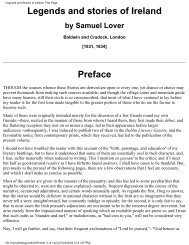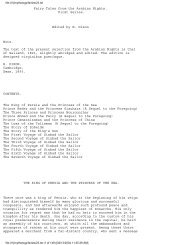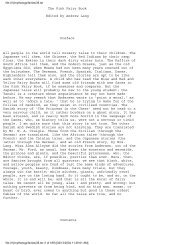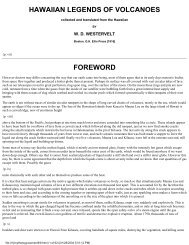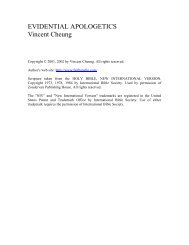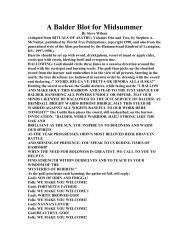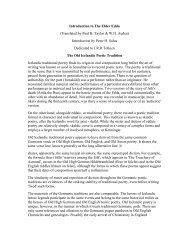Create successful ePaper yourself
Turn your PDF publications into a flip-book with our unique Google optimized e-Paper software.
3. So sind wir gezwungen, wenigstens die ersten Grundlagen des Buches den Anfängen den Aegyptischen Civilization<br />
beizumessen." See Naville, Das Aegyptische Todtenbuch (Einleitung), Berlin, 1886, p. 18.]<br />
{p. xiii}<br />
the Nile.[1] To fix a chronological limit for the arts and civilization of Egypt is absolutely impossible.[2]<br />
Evidence of the antiquity of certain chapters.<br />
The oldest form or edition of the Book of the Dead as we have received it supplies no information<br />
whatever as to the period when it was compiled; but a copy of the hieratic text inscribed upon a coffin of<br />
Menthu-hetep, a queen of the XIth dynasty,[3] about B.C. 2500, made by the late Sir J. G. Wilkinson,[4]<br />
informs us that the chapter which, according to the arrangement of Lepsius, bears the number LXIV.,[5]<br />
was discovered in the reign of Hesep-ti,[6] the fifth king of the Ist dynasty, about B.C. 4266. On this<br />
coffin are two copies of the chapter, the one immediately following the other. In the rubric to the first the<br />
name of the king during whose reign the chapter is said to have been "found" is given as Menthu-hetep,<br />
which, as Goodwin first pointed out,[7] is a mistake for Men-kau-Ra,[8] the fourth king of the IVth<br />
dynasty, about B.C. 3633;[9] but in the rubric to the second the king's name is given as Hesep-ti. Thus it<br />
appears that in the period of the XIth dynasty it was believed that the chapter might alternatively be as<br />
old as the time of the Ist dynasty. Further, it is given to Hesep-ti in papyri of the XXIst dynasty,[10] a<br />
period when particular attention was paid to the history of the Book of the Dead; and it thus appears that<br />
the Egyptians of the Middle Empire believed the chapter to date from the more<br />
[1. The date of Mena, the first king of Egypt, is variously given B.C. 5867 (Champollion), B.C. 5004 (Mariette), B.C. 5892<br />
(Lepsius), B.C. 4455 (Brugsch).<br />
2 See Chabas, Aeg. Zeitschrift, 1865, p. 95. On the subject of the Antiquity of Egyptian Civilization generally, see Chabas,<br />
Études sur l'Antiquité Historique d'après les Sources Égyptiennes, Paris, 1873--Introduction, p. 9.<br />
3 The name of the queen and her titles are given on p. 7 (margin) thus:--<br />
###.<br />
4 It was presented to the British Museum in 1834, and is now in the Department of Egyptian and Assyrian Antiquities.<br />
Todtenbuch, Bl. 23-25.<br />
6. the Ou?safaï's ui!o's of Manetho.<br />
7 Aeg. Zeitschrift, 1866, p. 54.<br />
8. See Guieyesse, Rituel Funéraire Égyptien, chapitre 64 e , Paris, 1876, p. 10, note 2.<br />
9. The late recension of the Book of the Dead published by Lepsius also gives the king's name as Men-kau-Ra<br />
(Todtenbuch, Bl. 25, l. 30. In the same recension the CXXXth Chapter is ascribed to the reign of Hesep-ti (131. 53, l. 28).<br />
10. Naville, Todtenbuch (Einleitung), pp. 33, 139]<br />
{p. xiv}<br />
remote period. To quote the words of Chabas, the chapter was regarded as being "very ancient, very<br />
mysterious, and very difficult to understand" already fourteen centuries before our era.[1]<br />
file:///I|/mythology/egypt/1/1.html (6 of 189) [01/25/2004 3:29:57 PM]<br />
Antiquity of Chapter LXIV.



